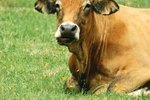The concept of using a large, potentially aggressive animal’s highly sensitive nose to control its behavior is as old as civilization. The Old Testament records, in 2 Kings and in Isaiah, that God used the nose ring as a metaphor in pledging to discipline Sennacherib, King of Assyria, for "raging against" Him around 700 B.C.: "I will put my hook in thy nose ... and I will turn thee back."
Ringing the Bull in History
Man learned a basic fact about animals early on: If you control the head, the body will follow. The ancient Egyptians applied this principle effectively through devices placed in the muzzles of their sacrificial beasts. Their domestic animals learned, if it hurts when you do that, don't do that.
The practice of placing a ring through the nasal septum of a bull may have traveled from the East to Europe and England via the Crusaders, as it is depicted in a pub game played in “Ye Olde Trip to Jerusalem," an ancient tavern reputed to be the oldest in that country.
The bull nose ring certainly came to the New World with the bulls themselves, because no pre-Columbian indigenous peoples had domestic animals larger than the llama that needed such control.
Why Ring a Bull?
Some bulls are ringed because they must be handled by humans at close range. Free-range bulls such as the Spanish fighting bull are not usually ringed. Bulls kept close quarters who show territoriality or aggression are usually ringed before they are full-grown, at less than 2 years of age.
Choosing a Ring
While the old-time bull’s nose ring was made of iron or brass, the modern ring is usually made of steel for durability -- you don’t want to go through this procedure twice, and neither does the bull. It is hinged in the center and usually sharp on one of the open ends so it makes its own hole in the septum. Once in place, it closes with a screw with a precise fit to form a smooth surface. An individual bull's ring is selected according to the bull's size -- future size considered.
Who Rings the Bull?
Under no circumstances should even the most experienced cattleman attempt to place a nose ring without veterinary help. For both safety and humane reasons, the animal should be both tranquilized and restrained. The vet will apply local anesthesia to the septum before placing the ring, to keep the animal from associating pain with human contact.
Once the nose has healed, the ring can be used with a halter, a lead rope or a bull staff. The bull staff is a 4-foot pole with a cautious cattleman on one end and a spring catch that clips to the bull’s nose ring on the other end. It's a tool that gives the handler added leverage, not to mention a head start.
Un-Ringing the Dinner Bell
You can’t unsay words you've spoken or "un-ring a bell." It is possible, however, to un-ring the dinner bell for a cow and her baby, by fitting the calf with a weaning ring. This ingenious device clamps to a calf’s nose without piercing it. It prevents a calf from nursing but allows the youngster to eat and drink like a big bovine. Left on until the calf stops trying to nurse, it’s a temporary solution to a temporary problem.
Rings in Other Noses
Oxen are not bulls; they are full-grown castrated male bovines used as draft animals. Some of these working beasts wear nose rings, put into use when being led or driven with reins. Putting nose rings on pigs may control destructive rooting but has been called a threat to their welfare.
References
- The Official King James Bible Online: 2 Kings 19:28
- Fenn Brahmans: Cattle Behavior
- Reshafim: Farmed and Domesticated Animals
- AppsZoom: Ring the Bull
- A to Z Vet Supply: Bull Ring Steel 3"
- Lifestyle Block, 2 October 2008: Livestock and Pets: Nose Ringing a Bull
- Farm Collector, Dec 2009: Livestock Collectibles; Leslie C. McManus
- Penn State College of Agricultural Sciences: Early Weaning Calves
- DairyBusiness: Calf Connection: Weaning Calves; Dr. Sam Leadley
- Beef Magazine: QuietWean Device Dramatically Cuts Down Calf Stress During Weaning
Resources
- The Incas: Domestic Animals
- Nativosite: Aztec Civilization
- Aficionados International: The Bull
- North Carolina State University, Robeson County Center: Bull Behavior and Handling Safety
- The Denver Channel, 6 July 2012: The Most Dangerous Animals In America Are ... Cows?
- Spiritus Temporis: Nose Ring (Animals)
- Gempler’s: Tailgate Training Tip Sheet® – No. 98: Dangers of Bulls and Other Cattle
- Wisconsin State Journal, 17 April 2012: Bulls Always a Dangerous Threat to Farmers, Rob Schultz
- Rural Heritage: Texas Longhorn Oxen
- Ingenta Connect: Animal Welfare, Volume 10, Number 1, February 2001, pp. 3-22(20) The Use of Nose-Rings in Pigs: Consequences for Rooting, Other Functional Activities, and Welfare; Horrell, R I; A'Ness, P J; Edwards, S A; Eddison, J C
Photo Credits
-
chirawan/iStock/Getty Images



